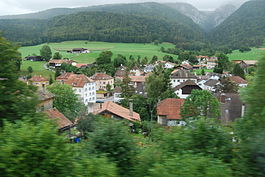Villeret, Switzerland
| Villeret | ||
|---|---|---|
 |
||
|
||
| Coordinates: 47°10′N 7°1′E / 47.167°N 7.017°ECoordinates: 47°10′N 7°1′E / 47.167°N 7.017°E | ||
| Country | Switzerland | |
| Canton | Bern | |
| District | Jura bernois | |
| Government | ||
| • Mayor | Maire | |
| Area | ||
| • Total | 16.24 km2 (6.27 sq mi) | |
| Elevation | 740 m (2,430 ft) | |
| Population (Dec 2015) | ||
| • Total | 927 | |
| • Density | 57/km2 (150/sq mi) | |
| Postal code | 2613 | |
| SFOS number | 0448 | |
| Surrounded by | Saint-Imier, Nods, Cormoret, Les Breuleux, Muriaux, Villiers | |
| Twin towns | Louzac-Saint-André (France) | |
| Website |
www SFSO statistics |
|
Villeret is a municipality in the Jura bernois administrative district in the canton of Bern in Switzerland. It is located in the French-speaking Bernese Jura (Jura Bernois).
Villeret is first mentioned in 1390 as Villeret.
During the Late Middle Ages and the Early Modern Era it was part of the seigniory of Erguel under the Prince-Bishop of Basel. After the 1797 French victory and the Treaty of Campo Formio, Villeret became part of the French Département of Mont-Terrible. Three years later, in 1800 it became part of the Département of Haut-Rhin. After Napoleon's defeat and the Congress of Vienna, Villeret was assigned to the Canton of Bern in 1815. In 1932 the Combe-Grède/Chasseral nature reserve was established in the municipal borders.
The village was part of the parish of Saint-Imier until 1951, when it separated to form an independent parish. The village Reformed church was built in 1936-37.
During the mid-18th century a number of forges, mills, sawmills and hammermills were built along the Suze river. The numerous mills and available water power attracted many blacksmiths, nailsmiths and locksmiths to the village. In 1725, the watch industry first entered the village and the craftsmen began producing watch parts. Starting in 1735, watchmaking moguls such as the Blancpain family built houses, infrastructure, factories and public areas to attract skilled craftsmen to Villeret. The completion of the Biel-Les Convers railroad in 1874 caused another population boom, which had reached its zenith by 1910. The financial crises of the 1930s and 1970s devastated the watch industry. The industry began to recover in 1993 when Cartier decided to open to factory in Villeret. This was followed in 2000 by the Straumann dental implants and instruments factory. However, in 2003, Cartier closed their factory. In 2005, the manufacturing sector makes up almost three-fourths of all jobs in the municipality.
...
Wikipedia




